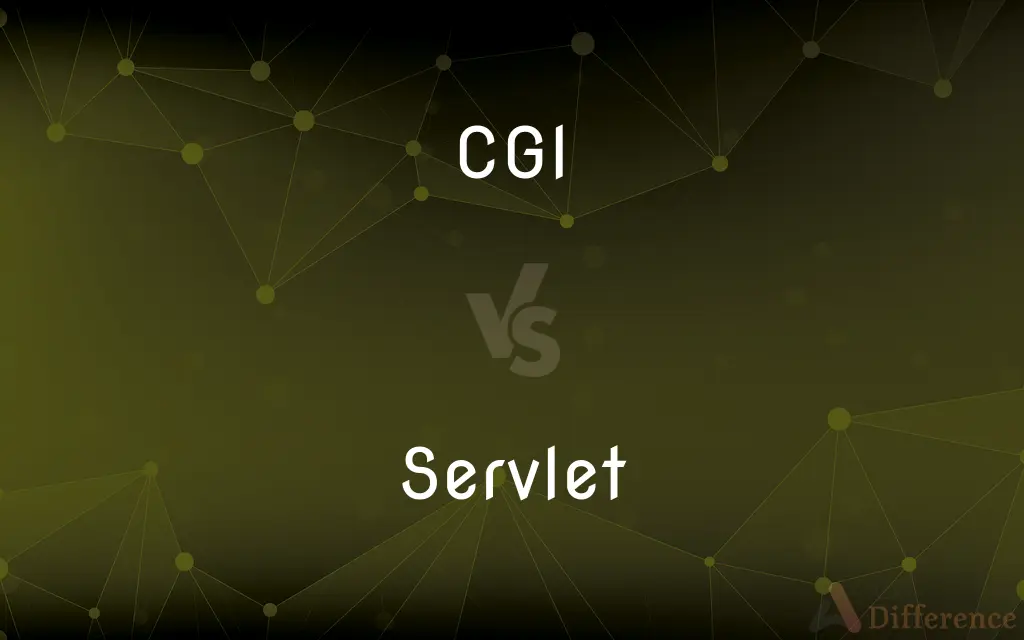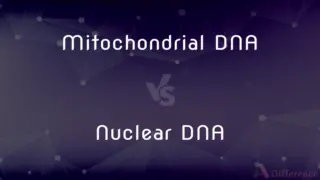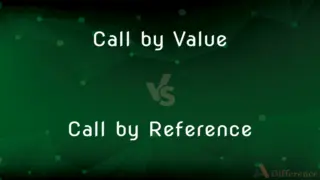CGI vs. Servlet — What's the Difference?
By Tayyaba Rehman — Published on January 10, 2024
CGI (Common Gateway Interface) relies on external programs for web requests, often slower due to process creation overhead. Servlet, a Java-based technology, executes within a web server, offering faster, efficient web application processing.

Difference Between CGI and Servlet
Table of Contents
ADVERTISEMENT
Key Differences
CGI operates by invoking external programs for each web request, causing process creation overhead, leading to slower performance. Servlet, being a Java-based technology, resides within a web server, enhancing performance by eliminating process creation for every request.
In CGI, web servers communicate with external programs for each request, impacting performance due to the frequent process creation overhead. Servlets, in contrast, execute within the web server, eliminating the need for external process invocation, resulting in faster response times.
CGI's reliance on external programs introduces overhead from process creation and communication, affecting performance. Servlets, as Java-based server-side technologies, offer improved efficiency by residing within the web server, handling requests more swiftly.
CGI's architecture involves spawning external processes for web requests, causing latency due to process creation overhead. Servlets, operating within the web server environment, bypass the need for external process invocation, ensuring quicker request processing.
Comparison Chart
Execution Environment
Depends on external programs for each request
Operates within the web server environment
ADVERTISEMENT
Performance Impact
Slower due to process creation overhead
Faster, eliminates process creation for each request
Technology
Independent of server-side technology
Java-based, integral part of Java EE (Enterprise Edition)
Overhead
Involves frequent process creation and communication
Avoids external process invocation, reduces latency
Integration
Communicates with web servers via external programs
Integrated into web servers, handling requests internally
Compare with Definitions
CGI
Often slower due to frequent process invocation.
The overhead of spawning processes in CGI can result in slower performance compared to other technologies.
Servlet
Integral part of Java EE for server-side processing.
Servlets are a crucial part of Java EE, providing server-side capabilities for web application development.
CGI
Relies on external programs for web requests.
CGI involves invoking external scripts for handling web requests sent to a server.
Servlet
Eliminates external process invocation, ensuring speed.
Servlets bypass the need for external processes, leading to faster response times in web application processing.
CGI
Causes process creation overhead, affecting speed.
CGI's reliance on external processes can lead to slower response times due to process creation overhead.
Servlet
Operates within the web server environment.
Servlets are Java-based components that execute within the web server environment for handling web requests.
CGI
Creates processes for each web request, impacting performance.
CGI's architecture involves creating new processes for each web request, which can slow down performance.
Servlet
Offers efficient server-side Java-based technology.
Servlets serve as efficient server-side Java technologies, processing web requests within the server environment.
CGI
Communicates with web servers via external programs.
CGI-based applications use external programs to communicate and process web requests.
Servlet
How does CGI differ from other server-side technologies?
CGI relies on external programs for each request, whereas technologies like Servlets operate within the web server environment, offering faster performance.
Servlet
What advantages do Servlets offer over CGI?
Servlets, operating within the web server, eliminate process creation overhead, ensuring faster and more efficient request handling.
Servlet
Can CGI integrate seamlessly into various web servers?
CGI communicates with web servers via external programs, allowing it to integrate with different server environments.
Servlet
Handles requests internally within web servers.
Servlets integrate into web servers, internally managing and responding to incoming web requests.
Servlet
Are Servlets suitable for complex web applications?
Yes, Servlets, being part of Java EE, are well-suited for complex web applications due to their server-side capabilities and Java's robustness.
Servlet
How do Servlets ensure quicker response times?
Servlets, being integrated into web servers, bypass the overhead of external process creation, leading to faster response times.
Servlet
Are there limitations to CGI's scalability?
CGI's reliance on external processes might pose scalability challenges for handling a large number of concurrent requests.
Servlet
Is CGI widely used in modern web application development?
While CGI had been popular, modern server-side technologies like Servlets have gained prevalence due to their efficiency and integrated nature within web servers.
Servlet
Is Servlet specific to Java-based environments?
Yes, Servlets are part of Java EE and are Java-based technologies specifically designed for server-side processing.
Servlet
Does CGI performance suffer due to process creation?
Yes, CGI's reliance on creating processes for every request often results in slower performance due to process creation overhead.
Servlet
Can CGI-based applications efficiently handle real-time data processing?
CGI can manage real-time data processing, but the overhead from frequent process creation might affect its real-time responsiveness.
Servlet
How do Servlets handle web requests efficiently?
Servlets execute within the web server environment, processing requests internally, and eliminating the need for external process invocation.
Servlet
Can CGI handle high volumes of web requests?
While CGI can manage requests, the overhead from creating processes for each request might impact scalability compared to more integrated solutions.
Servlet
How do Servlets integrate into web server environments?
Servlets integrate seamlessly into web servers, functioning as server-side components to process incoming web requests.
Servlet
What technologies can work alongside CGI for web application development?
CGI can work with various programming languages and scripts, enabling versatile web application development.
Servlet
Can Servlets be deployed across different web server environments?
Yes, Servlets, being part of the Java EE standard, can be deployed across various Java-compatible web servers.
Servlet
A Java program running on an Internet server that generates web content dynamically in response to requests from clients.
Common Curiosities
Does CGI performance suffer due to process creation?
Yes, CGI's reliance on creating processes for every request often results in slower performance due to process creation overhead.
Can CGI handle high volumes of web requests?
While CGI can manage requests, the overhead from creating processes for each request might impact scalability compared to more integrated solutions.
What advantages do Servlets offer over CGI?
Servlets, operating within the web server, eliminate process creation overhead, ensuring faster and more efficient request handling.
What technologies can work alongside CGI for web application development?
CGI can work with various programming languages and scripts, enabling versatile web application development.
How does CGI differ from other server-side technologies?
CGI relies on external programs for each request, whereas technologies like Servlets operate within the web server environment, offering faster performance.
Can CGI integrate seamlessly into various web servers?
CGI communicates with web servers via external programs, allowing it to integrate with different server environments.
Is Servlet specific to Java-based environments?
Yes, Servlets are part of Java EE and are Java-based technologies specifically designed for server-side processing.
How do Servlets handle web requests efficiently?
Servlets execute within the web server environment, processing requests internally, and eliminating the need for external process invocation.
How do Servlets ensure quicker response times?
Servlets, being integrated into web servers, bypass the overhead of external process creation, leading to faster response times.
Are Servlets suitable for complex web applications?
Yes, Servlets, being part of Java EE, are well-suited for complex web applications due to their server-side capabilities and Java's robustness.
Can CGI-based applications efficiently handle real-time data processing?
CGI can manage real-time data processing, but the overhead from frequent process creation might affect its real-time responsiveness.
Is CGI widely used in modern web application development?
While CGI had been popular, modern server-side technologies like Servlets have gained prevalence due to their efficiency and integrated nature within web servers.
Are there limitations to CGI's scalability?
CGI's reliance on external processes might pose scalability challenges for handling a large number of concurrent requests.
Can Servlets be deployed across different web server environments?
Yes, Servlets, being part of the Java EE standard, can be deployed across various Java-compatible web servers.
How do Servlets integrate into web server environments?
Servlets integrate seamlessly into web servers, functioning as server-side components to process incoming web requests.
Share Your Discovery

Previous Comparison
Mitochondrial DNA vs. Nuclear DNA
Next Comparison
Call by Value vs. Call by ReferenceAuthor Spotlight
Written by
Tayyaba RehmanTayyaba Rehman is a distinguished writer, currently serving as a primary contributor to askdifference.com. As a researcher in semantics and etymology, Tayyaba's passion for the complexity of languages and their distinctions has found a perfect home on the platform. Tayyaba delves into the intricacies of language, distinguishing between commonly confused words and phrases, thereby providing clarity for readers worldwide.












































